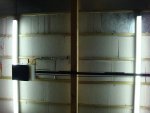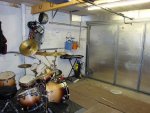Hi Alex and welcome to the board. First off, its very difficult to give a complete answer to your inquiry in a short reply, but I'll try to offer some hints. I also have some questions for you afterword.
1. Basically, for recording in the same room with performers, the person who is doing the engineering has a built in limitation. He CANNOT monitor the sonic qualitys the mic/mics pick up, on speakers. He MUST use headphones. This is because the mic will also pick up the sound of the speakers, which may or may not be bad, but definetly will change what is recorded. Not only that, but you as an engineer would hear not only the direct sound, but the sound from the speakers as well. Many engineers actually use a PA in the same room as the performers sometimes to get a certain sound. However, they are monitoring from a different isolated room, which allows them to hear what is actually being recorded as they are isolated from the direct sound.
Unfortunately, monitoring in headphones do NOT tell you the real sonic character of the sound from the mics. It is only an approximation, as opposed to those engineers who have the luxury of monitoring over speakers in a seperate room, which allows them to actually hear what the recording sounds like in a room, AS THEY RECORD IT.
Not only the engineer, but the musicians must also have a very good set of headphones which isolate the direct sound from the sound in their headphones., and a very flexible headphone distribution setup as well.
2. One room studios require very flexible recording setups as well. The main reason is space. Tracking in the same room with the musicians does not require the same type monitoring geometry as mixing does, as you are using headphones when tracking and overdubbing. However, mixing requires an equalateral triangle between the monitors and the engineer, which requires space in the room. If you are planning on tracking more than one musician at the same time, usually you will need to isolate one or more instruments via gobos, which also takes up space. In this case, a MOBILE console is prefered, to move it out of the way, as you are monitoring on headphones, and does not require the geometry that mixing does.
3. When recording in such a small room, especially rock music, the acoustics of the room are of little importance to the ambience of the recording. Except to the extent of modal resonances/flutter echo and comb filtering, which can ruin an otherwise good recording. In this respect, for small room recording of rock music, the accepted technique for room acoustics treatment is simple. ABSORB ABSORB ABSORB! In fact, the norm is to make the room as dead as possible, and ad reverb to taste during mixdown, and or to the headphone mix as desired during tracking.
However, this treatment approach is detrimental during mixdown, as the room response will lie to you, as you will find out when finally playing back the recording on other systems in other rooms. Acoustic treatment for mixdown requires a room with as flat room response as possible. Over absorbing the entire sonic spectum in a mixing environment will cause you to overcompensate EQ, which you won't be able to tell during mixing because the room is lieing to you. However, there is MUCH MUCH more to classic control room acoustics than I can get into here. Suffice to say, that is a book into itself. There are tons of information on this board as well as others. I won't go into it here in detail. However, this is the point of having a MOBILE console/monitor setup. Personally, I would design one end of the room for treatment geometry as the front wall in a mixing environment and make this permenant. The rest of the room I would design for mobile treatment(absorption as well as reflection), via gobos and or clouds. Various throw rugs will help too. One important aspect though, is low frequency absorption, which can be accomplished by use of superchunks of rigid fiberglass placed in all 4 vertical corners of the room, floor to cieling, and or 4" thick x 2'x4' panels of rigid fiberglass csuspended diagonally across wall/cieling intersections. These will help during tracking as well as mixing. In fact, low frequency absorption is the most important aspect of small room recording. Thats not to say there arn't others, but as far as treatment, it is the BIGGIE!

4. Transmission Loss...or, as most newbies call it..."soundproofing"...
ie, are you trying to keep the sound in the room from transmitting to the outside world and vice versa?
5. If so, then the next consideration is BREATHING

When you make a room AIRPROOF to keep sound from transmitting via the air by sealing the entire room, then you keep fresh air from entering the room to refresh that air that musicians breath. Not only that, but equipment and humans can quickly heat up a room that has been sealed. Therefore, the subject of ventilation and or HVAC become of prime importances. Suffice to say, now you have to deal with the problem of PENETRATING an building envelope that has been designed to keep air in. As soon as you penetrate this envelope, now you have to figure out how to keep sound from flanking through this system, which can ultimately waste your hard work and hard earned dollars. This subject is another book unto itself.
Hope this opens your eyes to a few things. These subjects have been covered to death on this bbs, as well as others. My best advice is to start reading as much as you can. One of the BEST resources is a book written by a fellow member here. His name is Rod Gervais and he is THE EXPERT!
http://www.amazon.com/Home-Recording-Studio-Build-Like/dp/1598630342






